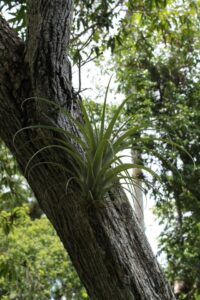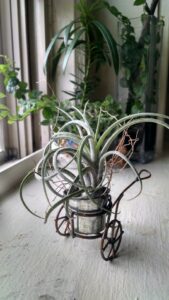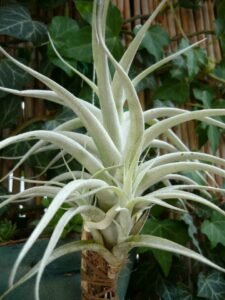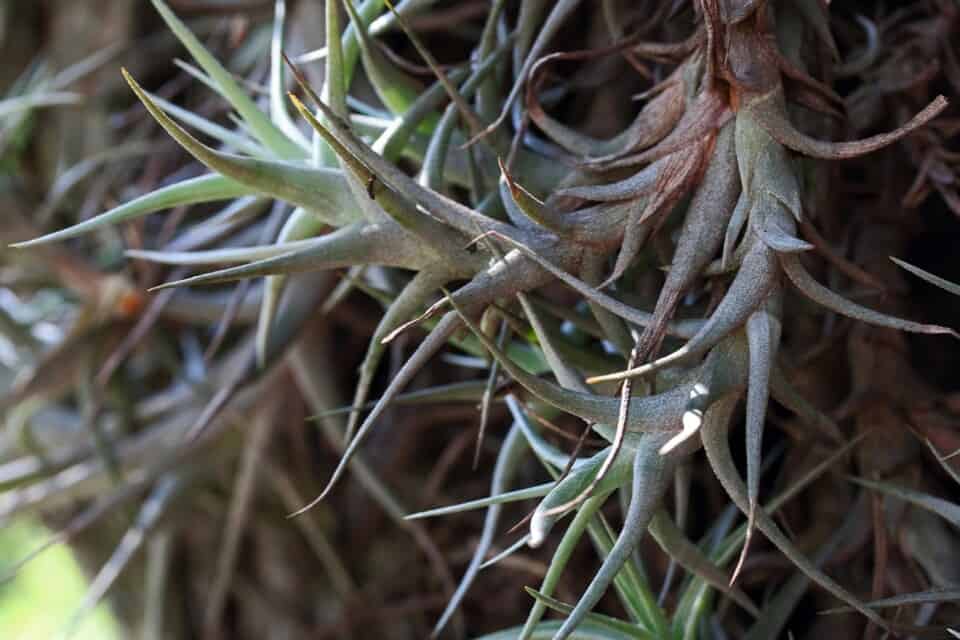Some links in the post are affiliate links and I get a commission from purchases made through some links found in the post.
Is yellowing normal in plants? If I had a dollar for each time someone asked me this question, I would probably have enough money to buy the Shenzhen Nongke Orchid.
Okay, I’m kidding. Not enough people have posed this question for me to rack up $200,000, but you get the idea. And yes, that orchid is on my bucket list as I work my way up to the Old Pine Bonsaii.
But back to the main question: is yellowing normal in plants? Should you expect your air plant to turn yellow at some point? Yes and no.
Yes, because aging is a normal part of the growing process, and the older leaves will inevitably die to create room for new growth. And no, because yellowing is often a cry for help.
If aging is not behind the change in color, your air plant turning yellow will likely owe to too much light, poor watering regimens of too much water, overfertilization, temperature stress, or even poisoning.
To fix this you need to identify the problem then fix the care practices.
I take you through some of the reasons your plant could turn yellow and what you can do about it before your air plant dies.
Why Are My Air Plant Leaves Turning Yellow?
An air plant turning yellow is not a sight to behold. After all, nobody nurtures these beauties to see them turn a sickly yellow, wither, and die.
Is there anything you can do about it? Sure! The first is to learn the causes behind yellowing so you can prevent the reoccurrence of this issue.
And the second is to figure out how (and if) you can reverse the effects of the causative agent. Let’s get started:
1) Overwatering
 What happens when you give an air plant too much water? Well, its roots suffer the effects of this action.
What happens when you give an air plant too much water? Well, its roots suffer the effects of this action.
They take up more water than necessary, and soon enough, the plant no longer needs to absorb the moisture around the roots. So, the saturated plant uses what it has, and the roots thus sit in moisture.
After a while, this humid environment becomes the perfect breeding ground for fungal growth. And soon enough, root rot ensues, damaging the roots and hampering the plant’s ability to make food.
That’s when you start noticing the plant’s physical changes, including yellowing, mold on the plant surface, and a horrible stench.
Unfortunately, root rot spreads fast, and by the time you see the yellowing, the damage is quite significant.
So, what causes overwatering? There are two main reasons for such an outcome:
- You are offering the plant more water than it needs, hence the root drowning, or
- You are housing the plant in a humid section where air circulation is insufficient, thus causing moisture accumulation.
Do you resonate with any of these causes?
Dealing with Overwatering
Of all the causes I will cover in this guide, I want you to be wary of overwatering as it is a known plant killer – not just for air plants but other species too. So, how can you get rid of this issue for good?
- Cut off the damaged plant parts: Assess your air plant and see how much of it has suffered the effects of the root rot. Then cut off the parts with soggy roots using a sterilized and sharp tool.
- Apply fungicide to the cut parts to prevent the growth of fungi, as this can trigger more root rot.
- Leave the plant in a sunny spot, ensuring it gets at least 6 hours of sunlight so that the excess water can evaporate into the atmosphere.
- Move the plant back to its original spot and alter its watering schedule such that you water it once weekly.
Hacking a watering schedule is easier said than done – I know it takes a bit of trial and error to balance the watering based on the humidity in your region.
To water the air plant, you must consider its species and choose a suitable watering method. The options include:
1) Dunking the Air Plant
If your plant can survive on a little water, i.e., is xeric, then this method will work. Fill a bowl with water and dip the plant severally in the water. Just like that, it can survive another week.
2) Soak the Plant
Plants that need more water (green and mesic air plants) are best soaked in water for about 15 minutes. Even so, you should limit the soak to once a week to prevent overwatering.
Only soak the plant twice if the plant develops dry tips, starts browning, or seems to be wilting. These are signs of dehydration, and if the plant is not in direct sunlight, underwatering could be the issue.
3) Spraying the Air Plant
You may have heard of misting. But have you come across spraying? It’s a thing! You use a sprayer to spray water on the plant until the excess moisture runs off the plant.
It’s like what the plant would get if it were to get rained on. However, the water can sit in the air plant cups, promoting root rot. So, it’s not exactly a popular way of watering these plants.
4) Misting the Plant
 Misting is like a bonus watering technique. You should not rely on it alone. Instead, you should use it to supplement soaking or dunking.
Misting is like a bonus watering technique. You should not rely on it alone. Instead, you should use it to supplement soaking or dunking.
And it’s only necessary when the humidity gets to such a low point that the plant can suffer. Use it in-between your main watering technique.
Don’t forget to ensure that the plant gets enough circulation so the water does not end up sitting on the plant. On this note, let’s address another crucial factor that could be behind the plant’s yellowing– poor lighting.
You may also like: 8 air plant problems & how to fix them
2) Direct Sun Exposure
Air plants grow in habitats where they receive filtered light that passes through the taller species’ leaves and branches before reaching them.
So, you can imagine that they would not appreciate direct sun exposure indoors. How does the sun harm these plants? Their leaves are not designed to receive direct sun rays.
As such, the light ends up damaging the leaves, making it hard for the leaves to photosynthesize.
And without adequate food to provide energy for the plant’s activities, the plant’s leaves start turning yellow, making it hard for the air plant to make food. And if you do not step in and do something about it, the plant will eventually die.
How Can You Fix Lighting Issues?
The main thing to remember is that air plants do well in bright and indirect light. That kind of light casts a medium shadow against an object.
And you can get it near (not against) an east or west-facing window. Alternatively, you can place the plant in a south-facing room, ensuring you add sheers to the windows to prevent the entry of direct sunlight.
Please note that these plants do not do well in low light. Do not move them from the sun to a dark hallway, bathroom, or another space with low light.
They cannot make enough food in such conditions. Moreover, they would be more susceptible to root rot, and we all know how that ends.
Consider using artificial lights if you cannot find a spot with balanced bright and indirect light. These supplemental lights work just as well as the sun’s rays.
Keep them on for about 12 hours a day if the plant does not receive any light from the outdoors. Or work out the difference between natural and artificial exposure and keep the lights on for as much time.
You may also like: How big can an air plant get?
3) Overfertilization
Outdoors, air plants do not need extra fertilizer as they can access moisture and nutrients from their surroundings. But indoors, they do not enjoy such luxury.
As such, you must step in to feed them once monthly with an air plant fertilizer. Or you can water them with rainwater, which would be enough to give them what they need to thrive.
The latter is the safest choice as it does not lead to the build-up of salts which can damage the plant roots, adversely affecting the uptake of moisture and nutrients.
With synthetic fertilizers, you must be careful; else, you can use so much that it kills the plant.
How Should You Feed the Air Plant?
Many air plant fertilizers contain copper, and copper poisoning can cause root damage, which exhibits as plant yellowing. You should only feed the plant once a month when watering it, per the fertilizer instructions.
Please note that other houseplant fertilizers are not suitable for air plants as these are epiphytic, and the solution thus enters the plants directly.
You may also like: How to care for an air plant over winter
4) Temperature Stress
 On the upside, air plants are highly adaptable and can do well in various temperatures. Ideally, you should set the temperature in your home between 55- and 90-degrees Fahrenheit.
On the upside, air plants are highly adaptable and can do well in various temperatures. Ideally, you should set the temperature in your home between 55- and 90-degrees Fahrenheit.
If it’s above this range, the plant can still survive, but it will need more water to stay hydrated. But temperatures below this range can shock the plant, especially when they near the freezing point.
And the plant can respond by exhibiting yellow leaves, which signal its inability to make food in the given conditions.
Can You Save Your Air Plant?
Unfortunately, getting an air plant out of shock is almost impossible. But you can save a plant which has had partial exposure to freezing weather or cold drafts.
So, if you notice any yellowing owing to cold drafts, you must move the plant to a warmer spot and cut off the damaged parts.
Final Thoughts
With these tips, you will be a few weeks, months, or years away from watching your plant bloom.
It’s a heart-warming experience that gives rise to more pups, giving you yet another experience to await. Happy Gardening!

